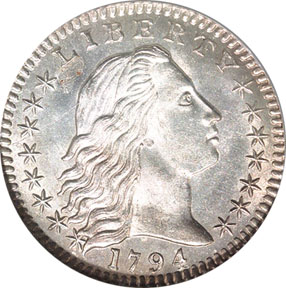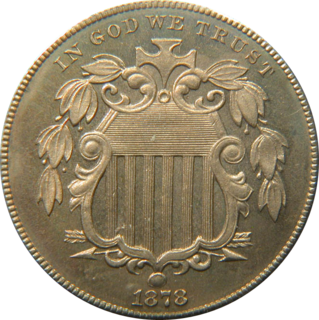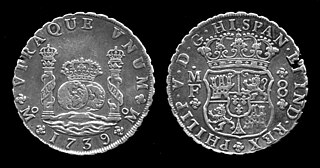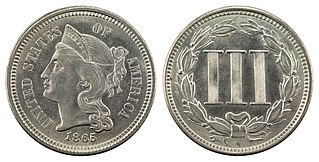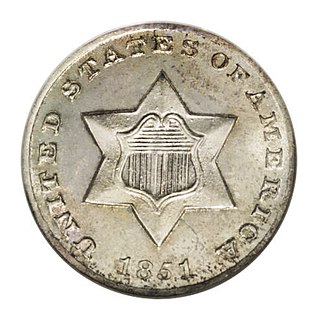This article needs additional citations for verification .(December 2006) |
The United States Mint has minted over 20 different kinds of coins, of many different sizes. Often, it is difficult for people to get a grasp of what much of the historical coinage looked like, at least in relation to modern circulating coins. This chart shows all of the coin types, and their sizes, grouped by coins of similar size and by general composition. [1]
Seven distinct types of coin composition have been used over the past 200 years: three base coin alloys, two silver alloys, gold, and in recent years, platinum and palladium. The base metal coins were generally alloys of copper (for 2 cent coins and lower), and copper/nickel (for 3 and 5 cent coins). Copper/nickel composition is also used for all modern "silver" coins. [2]
| Steel Alloy | Copper | Copper Alloy | Silver Alloy | Silver | Gold | Platinum | Palladium | |||
|---|---|---|---|---|---|---|---|---|---|---|
| Three Cent 14 mm 0.8 g 0.750 fine 1851–1853 14 mm 0.75 g 0.900 fine 1854–1873 | ||||||||||
| Half Dime 15.5 mm 1.24 g 1794–1873 | Dollar 15 mm 1.67 gr 1849–1889 | $5 American Gold Eagle 16.5 mm 3.11 g 1986–present | $10 American Platinum Eagle 16.5 mm 3.11 g 1997–present | |||||||
| Three Cent 17.9 mm 1.94 g 1865-1889 | Dime (Clad) 17.91 mm 2.268 g 1965–present | Dime 17.9 mm 2.5 g 1796–1964 | $2.50 Gold Quarter Eagle 18 mm 4.2 g 1796–1929 | |||||||
| Small Cent 19.05 mm 2.5 g 1943 | Small Cent 19.05 mm 3.11 g 1864-1982 | Small Cent 19.05 mm 4.67 g 1856-1864 2.5 g 1982–present | Three Dollar 20.5 mm 5.01 g 1853–1876 | |||||||
| Nickel 21.21 mm 5 g 1866–present | Nickel 21.21 mm 5 g 1942–1945 | Twenty Cent 22 mm 5 g 1875–1878 | $5 Half Eagle 21.6 mm 8.36 g 1795–1929 | $10 American Gold Eagle 22 mm 7.78 g 1986–present | $25 American Platinum Eagle 22 mm 7.78 g 1997–present | |||||
| Half Cent 23.5 mm 6.74 g 1795–1857 | Two Cent 23 mm 6.22 g 1864-1873 | Quarter (Clad) 24.26 mm 5.67 g 1965–present | Quarter (40% Ag) 24.3 mm 5.75 g 1976(S) | Quarter 24.3 mm 6.25 g 1796–1964 | ||||||
| Dollar 26.5 mm 8.1 g 1979–Present [3] | $10 Eagle 27 mm 17.5 g 1795–1933 | $25 American Gold Eagle 27 mm 17.5 g 1986–present | $50 American Platinum Eagle 27 mm 15.6 g 1997–present | |||||||
| Large Cent 29 mm 10.89 g 1793–1857 | Half Dollar (Clad) 30.61 mm 11.34 g 1971–present | Half Dollar (40% Ag) 30.6 mm 11.5 g 1965–1970, 1976(S) | Half Dollar 30.6 mm 12.5 g 1796–1964 | |||||||
| $50 American Gold Eagle 32.7 mm 31.1 g 1986–present | $100 American Platinum Eagle 32.7 mm 31.1 g 1997–present | |||||||||
| $20 Double Eagle 34 mm 35 g 1849–1933 | $25 American Palladium Eagle 34.036 mm 31.120 g 2017–present | |||||||||
| Dollar (Clad) 38.1 mm 22.68 g 1971–1978 | Dollar (40% Ag) 38.1 mm 24.59 g 1971(S)-1976(S) | Dollar 38.1 mm 26.73 g 1794–1964 | ||||||||
| $1 American Silver Eagle 40.6 mm 31.1 g 1986–present | ||||||||||
| Steel Alloy | Copper | Copper Alloy | Silver Alloy | Silver | Gold | Platinum | Palladium | |||
|---|---|---|---|---|---|---|---|---|---|---|
| | ||||||||||
 |  |  | ||||||||
 |  |  |  | |||||||
 |  |   |  | |||||||
 |  |  |  |  | ||||||
 |  |  |  | |||||||
  |  |  |  | |||||||
 |  |  |  | |||||||
 | 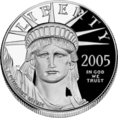 | |||||||||
 |  |  | 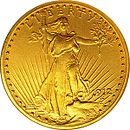 |  | ||||||
 | ||||||||||
 | ||||||||||
Notes on the tables:
- Images are close to actual size on a 92-dpi monitor.
- Clad Half Dollars, Silver Half Dollars and Dollars, and Gold Half Eagles and Eagles are still regularly minted as commemorative coins. Dimes, quarters and half dollars are also struck in 90% silver for special annual collector's sets.
- The silver-colored Susan B. Anthony dollar was replaced with gold-colored Sacagawea dollar in 2000 and Presidential Dollars 2007-2016; though the composition changed, the coin's size and weight remain the same.
- Some variances in coin size and weight occurred over time, especially as the value of silver varied. In particular, many silver coins changed in the 1870s. [4] The figures cited in the tables are representative of the series, and are generally the latest, or most common, figures for a given coin type.
The largest coin ever minted by the US Mint was the 2019 Apollo 50th anniversary 5ounce silver dollar, weighing 155.517 grams, and 76.2 mm in diameter. [5]






